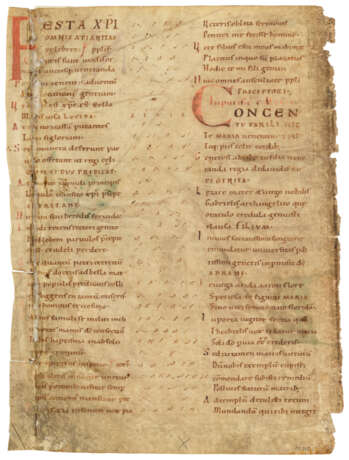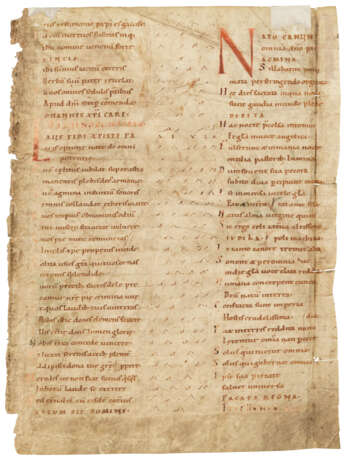ID 1053130
Lot 16 | German accent neumes
Estimate value
£ 4 000 – 6 000
A leaf from a Benedictine Proser, in Latin, manuscript on vellum [Germany, Bamberg/Würzburg area, second half 11th century]
A handsome example of Carolingian script and classic German accent neumes from a Proser or Sequentiary doubtless produced for a Benedictine abbey.
A substantial fragment of a single leaf, 282 x 207mm, originally part of a full bifolium, 2 columns of 35 lines written in a fine Carolingian minuscule in brown ink, one full column of music and one partial column in the outer margins, ruled space: 247 x 79; 247 x 40; 247x 79mm, classic German accent neumes, rubrics and large initials in red (perhaps recovered from a binding, consequently with some creasing and marginal staining). Loose in a folder.
Provenance:
(1) In a letter of 24 March 1982 to Albi Rosenthal, John. A. Emerson, musicologist and music librarian at the University of California, Berkeley, states that the provenance of the manuscript is 'certainly southern Germany, an area confined between Switzerland and Bamberg. It absolutely came from a Benedictine abbey from the region, such as Bamberg, Ingoldstadt, Heidenheim, Weissenburg, Würzburg, etc.'
(2) Albi Rosenthal (1914-2004), London, December 1988.
(3) Schøyen Collection, MS 205.
Text:
This leaf provides the texts of five Sequences (or Prosae), a poetic elaboration on the melody of the Alleluia chant in the Mass. The texts are: 'Johannes Jesu Christo, with partial melody (Feast of St John the Evangelist, 27 December); 'Laus tibi Christe', complete with melody (Feast of the Holy Innocents, 28 December); 'Nato canunt omnia, text only (Octave of Christmas, 1 January); 'Festa Christi omnis', complete with melody (Epiphany, 6 January); 'Concentu parili', text only (Feast of the Purification, 2 February).
Prosers from this period are often small books in single columns, and it is relatively unusual to find a collection of sequences written in this large two-column format. This suggests that the proser from which this page came may well have formed a component of a Gradual, the book of chants for the Mass.
Script and music:
The present fragment has affinities with a Gradual dated c.1040-60 in Vienna, Österreichische Nationalbibliothek, Cod. 1845. Emerson remarks on how the two-columnar layout is unusual, as is the presence and placement of 'Nato canunt omnia', which is not St Gall practice, but is found at Bamberg. The melodies for each line of the text are written in German neumes in the margin alongside the text, a position unique to sequences, where other chants normally have neumes written above the words.
| Place of origin: | Germany |
|---|---|
| Auction house category: | Medieval & renaissance manuscripts |
| Place of origin: | Germany |
|---|---|
| Auction house category: | Medieval & renaissance manuscripts |
| Address of auction |
CHRISTIE'S 8 King Street, St. James's SW1Y 6QT London United Kingdom | ||||||
|---|---|---|---|---|---|---|---|
| Preview |
| ||||||
| Phone | +44 (0)20 7839 9060 | ||||||
| Buyer Premium | see on Website | ||||||
| Conditions of purchase | Conditions of purchase |




